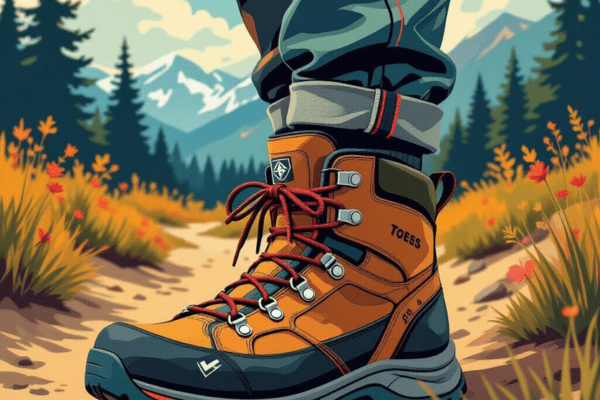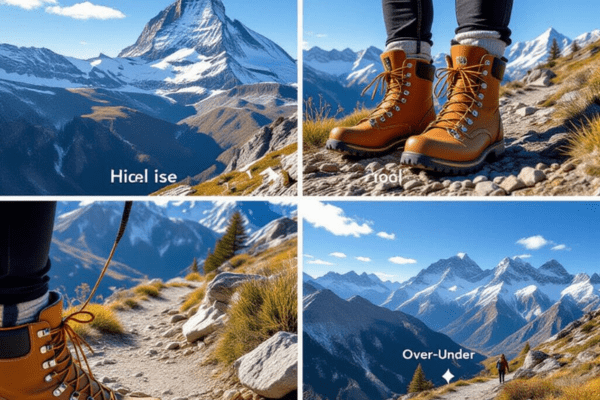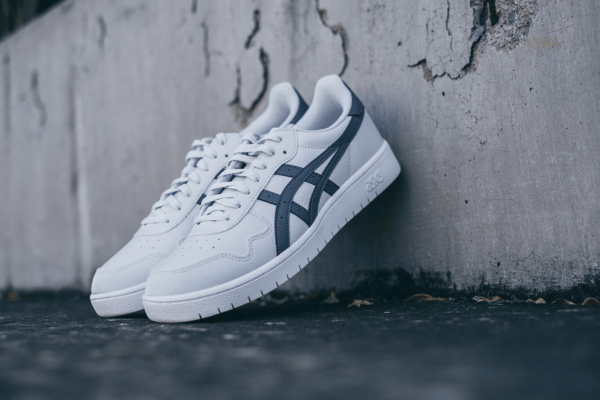Introduction
When it comes to hiking boots, most people focus on size, cushioning, or grip—but overlook one critical factor: the lacing technique. It might seem like a small detail, but how you lace your boots can have a big impact on your comfort, performance, and even foot health.
So, why is lacing technique important in hiking boots? Because proper lacing keeps your feet secure, reduces pressure points, and prevents blisters, toe bang, or ankle strain during long hikes. A poor lacing method can lead to pain, unstable footing, and even long-term injuries.
In short, why does hiking boot lacing matter? It helps your boots fit better, improves trail performance, and keeps your feet supported on every step. Whether you’re hiking uphill, downhill, or on uneven terrain, mastering the right lacing technique can make all the difference.
Why Lacing Matters: Comfort, Fit & Support
When it comes to hiking, your boots can make or break the experience. But even the best boots won’t help if they’re not laced properly. So, why is lacing technique important in hiking boots? Because the way you lace your boots directly affects your comfort, support, and overall performance on the trail.
Benefits of Correct Boot Lacing
Using the right lacing technique helps distribute pressure evenly across your foot. This prevents hotspots, blisters, and painful toe bang during steep descents. Proper boot lacing helps secure your heel, keeping your foot steady and lowering the chances of twisting your ankle during a hike.
How Boot Lacing Improves Comfort
A well-laced boot feels like a custom fit. By adjusting the tension in different zones (toe, midfoot, ankle), you can reduce pressure points and increase blood flow. That’s how boot lacing improves comfort, especially on long hikes when your feet swell or get tired.
Do Lacing Techniques Affect Fit?
Absolutely! Different lacing techniques affect fit in specific ways. For example, window lacing relieves pressure on the top of the foot, while heel-lock lacing improves ankle support. These techniques are key to getting the right fit without changing your boots.
Hiking Boot Fit Guide Essentials
Your lacing style should match your foot shape and trail type. Wide feet? Try skipping eyelets or using flexible patterns. Downhill hike? Use over-under lacing for added grip. These small tweaks make a big difference and are a core part of any smart hiking boot fit guide.
How Lacing Affects Hiking Performance
Proper lacing doesn’t just feel better—it helps you hike better. With a snug, supportive fit, your movements become more efficient and balanced. That’s how lacing affects hiking performance and helps you go farther with less fatigue.
In short, mastering lacing isn’t just about comfort—it’s a performance tool. So next time you hit the trail, remember: Why Is Lacing Technique Important in Hiking Boots? Because it’s your first step toward a safer, more enjoyable hike.
Foot Health: PreventingFoot Health: Preventing Blisters, Pain & Pressure
Hiking is supposed to be challenging—but not painful. One of the most overlooked ways to protect your feet on the trail is proper boot lacing. Whether you’re a casual hiker or a seasoned trekker, understanding the importance of proper lacing in hiking boots can make a huge difference in your comfort and performance.
Can Lacing Technique Reduce Foot Pain?
Yes! An effective lacing method spreads pressure evenly over your foot, minimizing tension and preventing painful pressure points. If your feet ache during or after hikes, it may not be your boots—it could be how you’re tying them.
This is where lace pressure adjustment comes in. Loosening or tightening laces in specific areas can relieve tight spots and help align your boot’s fit with your foot’s natural shape. Knowing how to fix pressure points with boot lacing can prevent strain on arches, ankles, and toes.
Does Proper Lacing Prevent Blisters?
Absolutely. Blisters are often caused by friction, which comes from loose-fitting boots or constant movement inside the shoe. Correct lacing locks your heel in place and prevents sliding, reducing the risk of rubbing.
This directly ties into the benefits of correct boot lacing—a snug, secure fit that minimizes movement and protects skin. Using lacing methods like heel-lock or window lacing can help even more in high-friction areas.
Toe Bang Prevention: A Must on Downhill Trails
Toe bang happens when your foot repeatedly hits the front of your boot—usually while walking downhill. This can bruise toenails or cause black toenails over time. The solution? Adjusting your laces to secure the heel and prevent forward foot movement.
How Lacing Affects Hiking Performance
The right lacing technique doesn’t just reduce pain—it improves performance. When your feet are supported, you’re able to hike longer, faster, and with less fatigue. The importance of proper lacing in hiking boots becomes clear the more you hike with comfort and confidence.

Lacing for Specific Foot Shapes & Conditions
Finding the right lacing technique can make a huge difference for hikers with unique foot needs. Whether you deal with wide feet, bunions, or frequent toe pain, adjusting your boot lacing can relieve pressure, improve foot stabilization, and enhance comfort on the trail.
Lacing for Bunions and Wide Feet
If your boots feel too tight across the front or sides, you’re not alone. Many hikers struggle with bunions and wide feet, leading to soreness and discomfort during long hikes.
Try this method:
- Lace through every other eyelet to loosen tension over the toe box.
- Try side-thread lacing by avoiding crossovers directly above the bunion area.
This allows more room for your forefoot while still offering ankle support and keeping your foot secure.
Pro Tip: Use flat, flexible laces to reduce surface pressure on sensitive areas.
How to Lace Boots to Avoid Toe Pain
Toe pain on downhill hikes is often caused by your foot sliding forward and hitting the boot front. Try side-thread lacing or use the heel lock method—also called a runner’s loop or lace lock—to secure your foot and reduce heel slippage.
How to do it:
- Lace up normally until the top two eyelets.
- Loop the laces back through the last eyelets to form a secure lock.
- Tie tightly to hold your heel in place.
This method prevents slippage and keeps your toes from jamming while still maintaining solid foot stabilization.
Why Lacing Matters
Using the right lacing method isn’t just about comfort—it improves safety too. With effective boot-lacing techniques, you can reduce foot fatigue, prevent injury, and ensure proper ankle support across uneven terrain.

Popular Hiking Boot Lacing Techniques (Explained Simply)
Finding the right way to lace your hiking boots can make a big difference in comfort, support, and performance on the trail. Whether you’re going uphill, downhill, or hiking all day, tightening hiking boots correctly can help prevent blisters, reduce pressure points, and improve your overall hiking gear fitting.
Here are four popular hiking boot lacing techniques, explained step-by-step, to help you get a secure, pain-free fit.
1. Heel Lock Lacing (a.k.a. Lock Lacing)
What is heel lock lacing?
Heel lock lacing helps keep your heel in place, especially when going downhill. It prevents your foot from sliding forward and reduces toe bang or bruised toenails.
How to do it:
- Lace up your boots as usual until the top two eyelets.
- Rather than crossing over, insert each lace straight up into the top eyelet on the same side to form a vertical loop.
- Cross the laces and tuck them into the opposite loop, then pull tight and tie.
Best for: Steep descents, preventing heel slippage
Helps with: Preventing foot pain with lacing
2. Window Lacing Technique
What is the window lacing technique?
Window lacing (also called box lacing) relieves pressure on the top of your foot—ideal if you feel discomfort across your instep.
How to do it:
- Lace normally up to the pressure point.
- Instead of crossing, run the laces straight up to the next set of eyelets.
- Resume normal lacing above the skipped eyelets.
Best for: Pressure relief on the top of the foot
Helps with: Hiking gear fitting and circulation issues
3. Surgeon’s Knot for Hiking Boots
The surgeon’s knot hiking boots method creates a secure hold at any part of the boot where slippage is common. This is especially helpful if your boots loosen while walking.
How to do it:
- Stop at the area where your boot feels loose.
- Wrap the laces around each other twice (like a double knot), then pull tight.
- Continue lacing as usual or add another surgeon’s knot higher up.
Best for: Midfoot lockdown
Helps with: Tightening hiking boots correctly
4. Over-Under Lacing for Boots
Over-under lacing for boots creates even tension across the foot and helps with long-term comfort on long hikes.
How to do it:
- Start with the lace going under the first eyelets.
- Go over the next, under the next, and so on.
- Tie as usual at the top.
Best for: Even pressure distribution
Helps with: Preventing hotspots and keeping laces secure all day

Final Thoughts
Using the best lacing techniques for hiking isn’t just about snug boots—it’s about preventing injury, avoiding pressure points, and improving the overall fit of your hiking gear. By learning methods like heel lock lacing, window lacing, the surgeon’s knot, and over-under lacing for boots, you’re making a big step toward preventing foot pain with lacing.
Lacing for Terrain: Uphill, Downhill & Variable Trails
Different hiking terrains demand different lacing techniques. No matter if you’re hiking uphill, going downhill on rocky paths, or walking across uneven trails, your lacing method plays a key role in your comfort, stability, and safety.
How Terrain Affects Lacing Tightness & Control
When hiking uphill, loose lacing near the toes and snug lacing around the ankles helps with forward movement while reducing toe pressure. On the other hand, downhill trails require tighter lacing near the toe box to prevent your feet from sliding forward and causing toe bang or blisters. For variable trails, a balanced lacing approach is best—keeping even pressure across the foot while allowing flexibility.
How to Lace Hiking Boots for Downhill/Uphill Trails
- For uphill hikes, try the window lacing method—it eases pressure on the top of your foot while giving extra support around the ankle.
- Downhill: Try the heel lock or surgeon’s knot to keep your heel in place and avoid forward foot slippage.
- Mixed Terrain: Combine techniques for pressure distribution and better support.
Does Lacing Style Change for Terrain?
Yes, absolutely. Lacing style should be adjusted based on the terrain you’re hiking on. For instance, proper lacing for trekking boots in mountainous regions differs from what you’d use on flat trails. Adapting your lacing style improves balance and reduces fatigue.
Lacing Boots for Long Hikes
For long-distance hiking, comfort is everything. Focus on:
- Even lace tension
- Reducing hot spots
- Secure ankle support
This helps with pressure distribution, reduces the risk of injury, and keeps your feet happy mile after mile.
Boot Lacing Tips for Beginners (Simple & Practical)
For New Hikers or Casual Trail Users
Getting your hiking boots to feel just right can make or break your outdoor experience. Whether you’re heading out for a short nature walk or a full-day trek, these boot-lacing tips for beginners will help you stay comfortable, safe, and blister-free.
Here are 6 easy lacing tips to improve your hiking boot fit and lacing without confusion:
1. Start with the Right Boot Fit
Before you even lace up, make sure your boots fit properly. There should be enough space for your toes to move freely, while your heel remains snug and secure without slipping. A good fit is the foundation of tightening hiking boots correctly.
2. Use the Over-Under Lacing Method
This method reduces pressure points and holds your foot more securely. It’s a popular choice for beginners because it improves comfort and control on uneven ground.
3. Lock Your Heel with the Heel-Lock Technique
If you notice heel slippage or blisters, try a heel-lock (or surgeon’s knot) above the ankle. It’s one of the most effective boot-lacing tips for beginners to stop friction and give better ankle support.
4. Adjust Based on Terrain
Hiking terrain adaptation matters! Loosen your laces slightly on uphill climbs to ease toe pressure. Tighten them for downhill sections to prevent your foot from sliding forward.
5. Don’t Overtighten
You might wonder, how tight should you lace hiking boots? The answer is snug, not painful. Your foot should feel secure but not numb. Circulation is key, especially on long hikes.
6. Re-Lace Mid-Hike if Needed
Your feet swell over time. Pause during the hike to adjust your laces if they feel too tight or too loose. This small step can save you from big foot problems later.
Final Thoughts
You don’t need fancy gear or expert knowledge to get started—just a few practical hiking gear tips like these. And yes, the answer to Is there a correct way to lace hiking boots? is absolutely. The correct way is the one that gives you support, reduces pressure, and adapts to your hike.
So, lace up smart and hit the trail with confidence!
Conclusion
Now you know why lacing technique is important in hiking boots—it’s not just about keeping your shoes on. The right lacing method can improve comfort, reduce toe pressure, boost ankle support, and help prevent blisters on long trails.
A proper hiking boot fit guide always includes smart lacing tips, because even the best boots won’t feel right without proper adjustment. From heel lock lacing to over-under techniques, small changes in how you lace your boots can make a big difference in stability and performance.
Don’t settle for pain or poor fit—experiment with different lacing styles to find what works best for your feet and terrain. Better lacing = longer, safer, and more enjoyable hikes.
BestShoeLaces.com is your trusted hub for lacing techniques, shoe fit solutions, and top-rated lace styles.
From casual wear to hiking boots, we’ve got your feet covered.
FAQs
1. What’s the best way to lace hiking boots for ankle support?
The best method for ankle support is the heel lock (or surgeon’s knot) technique. It keeps your heel in place, prevents rubbing, and adds extra stability on rough trails. According to every smart hiking boot fit guide, this lacing style is ideal for hikers with weak ankles or steep descents.
2. How does lacing prevent foot fatigue?
Proper lacing distributes pressure evenly across your foot, reducing muscle strain and toe bang. It also keeps your foot from sliding forward, which helps you stay energized during long hikes. That’s why lacing technique is important in hiking boots—it prevents fatigue before it starts.
3. Which lacing method helps on long hikes?
For long hikes, try the over-under lacing or window lacing method. These reduce lace pressure over sensitive areas and improve blood flow. Smart lacing ensures comfort and performance across changing terrain.
4. Should you retighten laces mid-hike?
Yes! It’s smart to check and re-tighten laces mid-hike, especially after your feet swell. Adjusting laces throughout your hike improves fit, reduces pressure points, and keeps your hiking boots feeling secure.
5. What’s the best way to lace hiking boots for ankle support?
To protect your ankles, try the heel lock lacing technique. It secures your heel, reduces slipping, and adds stability on steep or uneven trails. A good hiking boot fit guide always recommends this for better ankle control.


